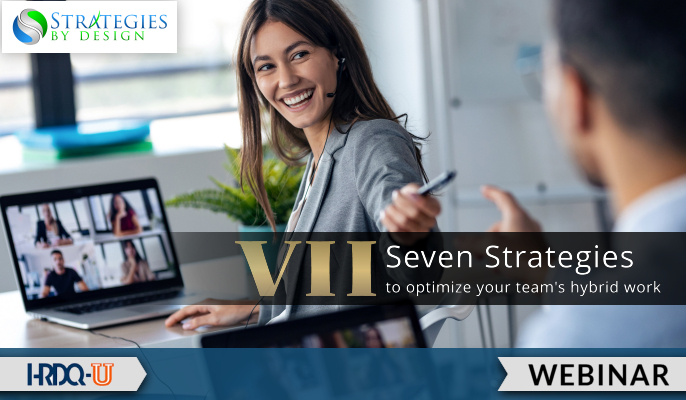- 827 Lincoln Ave. #B-10 West Chester, PA 19380
- support@hrdq.com
- +1-610-279-2002
Quick Links
Menu
Featured Topics
Menu
Total Results
We could not find what you're looking for. Please try again.No Record Found

Hybrid work is here to stay, yet many organizations still grapple with virtual meeting fatigue, low employee engagement, and creating a workplace environment that supports work-life balance. Let’s face it, many of us simply roll our eyes at the very thought of another virtual session or, as a leader, hint at the same idea that it is somehow easier to work remotely.
During our session, we will address these friction points and highlight seven proven strategies that will act as an antidote to your virtual meeting fatigue, enhance employee engagement, and optimize the effectiveness of your teams’ hybrid work.


Judith Cardenas is the President and CEO of Strategies By Design, a consulting firm helping organizations across the globe to innovate and design successful solutions and experiences for their clients. She has spent the last 10+ years empowering leaders and organizations to execute their vision and reach their goals through processes focused on innovation, change, and co-creation.
Her academic background includes a doctorate in education administration, as well as a doctorate in training and performance improvement. She has completed a variety of postdoctoral training in topics such as innovation, design thinking, digital facilitation and AI.
Judith has created and delivered training to organizations and agencies such as the World Bank, United Nations, QVC, Inc., Phillips Semiconductor, U.S. Navy, U.S. Nuclear Regulatory Agency and U.S. Army, National Institute for Staff and Organizational Development/UT Austin and American College of Radiology.
Connect with Judith on LinkedIn.
Stephanie McGreaham is an HR leader with a passion for helping businesses develop and expand their employee engagement. With a background in change management and leadership, she is certified as a Senior HR Professional with HRCI and has over 15 years of experience working with industry leaders to achieve their organizational vision. Stephanie is the Partnerships Manager at Howspace.
At Strategies by Design Group, we specialize in supporting Leaders and Organizations that are ready to innovate faster and more successfully – and want to design better solutions, or experiences for their customers and employees. We help foster the culture of innovation needed to stay competitive in today’s modern, ever-changing market, apply innovative techniques and approaches to achieve immediate engagement and growth and enhance the connection between behavior design and human centric design.
Learn more at www.strategiesbydesigngroup.com.

“It was really interesting hearing the various insights from the team and I enjoyed learning about the selection of tools that could be used in digital facilitation.”
Michelle M.
Innovation Program Coordinator
Beca

“Excellently presented informative webinar full of new ideas and resources. I’ve downloaded the ebook and plan to read through it thoroughly to learn more about hybrid work models in order to be more effective with my team and work.”
Angela F.
Program Coordinator
Arkansas State University

“Great session. Getting to know about digital facilitation and how to ensure success in virtual facilitation through creating a framework was nice.”
Raquel C.
Learning Services Manager
TELUS International

Sign up to be notified of upcoming live webinars, in-depth workshops, podcasts, blog posts, promotions and much more. Stay ahead of the curve and subscribe for FREE today!
One Response
Q&A from the webinar.
Question: I understand that boundaries are important, but how do you get others to accept those boundaries? For example, I’m off the computer by 5 PM to be with my family.
Answer: So for me, it’s all about communicating expectations. And one of the things that I’ve struggled with in my career that I’m working to get better at, is being OK with saying no, and reinforcing those boundaries after you set your expectation that you’re going to end the day at 5PM. A big piece is just that communication in the onset and making sure that people understand when you’re available and the time it takes to communicate with one another. As you go, you can adjust, but it’s important to set those expectations right out of the gate.
Question: Does house space make sense for an outward facing program? We do not provide internal training.
Answer: Yes. I would say in any situation where you’re looking to include dialog and collaboration, the way that house space works is you have access to an unlimited number of workspaces. And the way that I like to describe a workspace is, it’s sort of like its own project. It’s got its own, its own theme or subject to it. So, once you have that workspace, you can invite internal or external people into that workspace, and share content, and collaborate with those widgets that I was referring to in the presentation. So, absolutely, we find it works very well, not just internally, but externally as well.
Question: Can you use the tools that were discussed today when some people are in person, and some are virtual?
Answer: Yes. Very much so. You know, we use the tools for face-to-face, as well as for our people who are, you know, work virtually. There are, it’s the combination of the tools that is probably the most critical. So sometimes, we’ll always use Canva to design some type of visual, but at times, you know, our polls may be one poll, whether you’re in the office or out of the office. It’s the same poll, no widget that we use at the same poll link, but yes, the tools can be used interchangeably, and they can be used for people that are outside, remote, and you know face-to-face.
Question: What techniques do you find the most effective when creating a collaborative experience?
Answer: So a couple of things about collaboration is that, true collaboration is really about having everyone’s voice heard. And understanding the diversity of perspective, so we find that the best elements that will reduce bias. An increased collaboration is what we call blindfolding, so many times we’ll have an idea, or we have a project. We have some initiative that we’re looking at together. Instead of having everyone vote in a Zoom meeting, for example, we open it up to blind voting. We know we create a poll, or we create some. We use another tool to actually vote. You just vote blindly. We don’t know who voted for what. That helps that one step has really decreased bias and increase collaboration, at least by 50%.
Question: Since hybrid work is our new norm, what two tools would you consider the most critical in creating a collaborative environment?
Answer: So, I definitely, from the tools that we share today, I definitely would say, house space and a whiteboard. Yeah, the whiteboard does give people the ability to, to write text, or design, or draw, or whatever it may be. And big house space, we’ve used it a lot with teens, some that are very hierarchical, while others are very free floating, but the ability to understand sentiment, and to understand themes that are emerging, as you’re trying to facilitate that led to the next step. Because one of the most critical elements that we have back, so those would be the two tools I would take, if I were on an island, by myself.
Question: What biggest challenge you face when onboarding a new employee into your virtual workspace?
Answer: I would say, I guess I’ll start, as someone who, who’s been onboarded in a virtual space. The biggest challenge is making sure that that person knows that they have connections and people that they can reach out to. So, if there’s any way that you can put together some kind of directory, or matrix, of who to go to, for what, I know, when you start a new job remote, it can feel so isolating if you’re not immediately immersed in the culture or getting a great orientation schedule put together. So, if you’re on the flip side of that, as the new hire coming in, I would, I would recommend being as proactive as possible and, in your outreach, to get to know your co-workers and, and be aggressive in scheduling those meetings to make that happen.
Question: Looking back, what has been the greatest lesson you have learned?
Answer: I think, for me, working in the remote space or virtual spaces is to always keep a mindset of curiosity. You know, I’m curious about why certain people like certain tools, why certain people like to show their camera. Or have a background from Hawaii behind them. It is a very good, you’re keeping an open mind and a might of curiosity helps me stay very centered on the people we’re trying to serve.